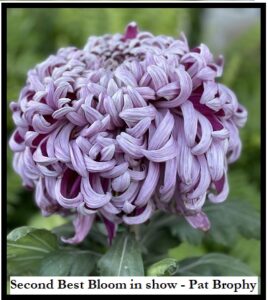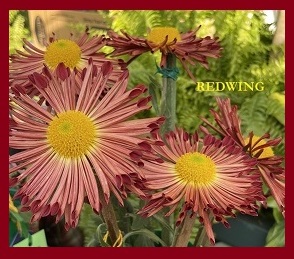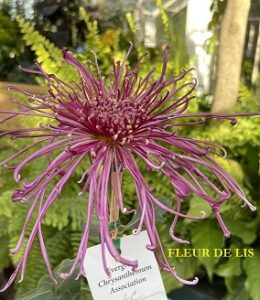August is still a major growing month so continue with the usual summer watering feeding and pest control programs up until the buds are taken. Continue to stake and reduce the number of laterals as buds appear. Experience suggests there is no way to get too much support for the laterals and blooms. By mid-August we will have switched to the bloom cycle program with new fertilizing, watering and plant care programs so stay alert.
- Staking and Lateral Control:
-Continue with staking until all laterals are securely tied to stakes,
-Surplus laterals are removed after the buds are firmly established, showing color and free of defects and blemishes. With 2 1/2 months until the ECA show, it may be prudent to delay the final reduction in consideration of possible bug damage, wind or accidents. Holding on to a spare lateral too long might reduce the bloom size a small amount, but there’s an old saying that “I carry three, one for the bug and 2 for me”. It’s up to each individual when to cut back to the final number of laterals.
-Recommended number of laterals for the final count are listed below.
For #1s & #2s, Carry 1 or 2 laterals
For #3s or 13s, carry up to 5 laterals, gradually cull to 3 or 4 in Sept.
For #4s or 14s, Carry 2 or 3 laterals
For #5s or 15s, Carry 2 to 5 laterals
- Flushing and Top Dressing:
In early August you should flush your pots to reduce the accumulation of salts on the pot and in the growing medium, (See July Newsletter). Follow the flushing with top dressing. Spread 1-2 hands full of the 9” mix on each pot. This gives the upper roots a better growing environment now and helps promote new shoots for next season. - Fertilizing and watering:
-Continue your mid-season feeding and watering program right up till the bud is taken.
Water thoroughly when you water then let the plants almost dry out before watering again. For these hot days it is recommended you water early in the morning, or else later in the evening, i.e. 6:00 pm. Don’t water the plant just because you are passing by with the hose. Wait till it needs watering!
– Feed as usual up to when the bud is taken with the mid-season fertilizer. If you are a heavy feeder and your plant leaves are getting turgid or the upper leaves are turning over that’s a sign of too much feed; so reduce it or skip a feeding. Overfeeding at this stage will probably ruin your blooms.
When the buds appear, stop feeding or reduce the feed level to ½ or less of your previous feed level for 2-3 weeks, then resume feeding with the new bloom cycle formula at a much reduced rate (More Later).
- Blooms and Bloom Support:
-Watch for buds and secure them as they appear. Most buds will have appeared by August 15th. Look for “rabbit-ear” leaves below the tiny bud. As the bud reaches the size of a very small pea, it should be secured by removing the ring of side buds and the other side shoots that may appear in the leaf axils below. This action is called “taking the Bud”. After the bud is taken the plant will start producing side shoots at the lower leaf axels for some time. Keep all these sides shoots removed so that the plant strength will go into developing the bud.
-For bloom support, prepare strips of wood 16’ to 18’ long and 3/8” wide made from shingles, shakes or ¼” plywood. Stain them green preferably. These are made to support each bloom, keeping the lateral growing straight and preventing bloom cocking. They are tied to the main stake and to the bloom stem. bloom support stakes will be available at the August meeting.
Keeping the top just below the bloom to prevent cocking, or with a slight pressure it can help straighten the bloom. A cocked bloom will never win a major award. - Bloom Cycle Care:
By mid-August, after the buds have been taken, it’s time to revise our feeding program. We switch to a new fertilizer formulation that is higher in potash content and at the same time reduce the overall amount of feed throughout the bloom cycle. Generally we will have to change our watering program as well. Here’s the plan.
– First we give the plant a potash boost to start the hardening off cycle. Starting the second week in August we feed each pot with ½ tsp of granular sulfate of potash, applied to the top of the pot and repeat 2 weeks later with ¼ tsp potash. Water it in so as not to burn the roots. This is to harden off the plants and promote better bloom development.
-As soon as the bud has been taken (Sometimes that’ in July instead of August), we reduce our liquid feeding level to ½ to ¼ what you were previously using. If you have been feeding heavily, you might want to reduce it further so as not to damage the bud in its early development stage. A good position at this time is ½ tsp per Gal. of water once a week of our new bloom cycle fertilizer formulation with a higher potash concentration.
- Bloom Cycle Fertilizer.
Here’s the recommendation for bloom cycle feeding: – 1/2 tsp of our standard 4-18-38 late season fertilizer or 1/2 tsp of 20-10-20 ( mid season fertilizer) with ¼ tsp of sulphate of potash fertilizer per gallon of water. Note, the potash fertilizer does not dissolve easily so you might try mixing it with a small amount of warm water and letting it set a while.
-Watering, The plants won’t require as much water during the bloom cycle so you might apply only a pint of water per pot and likewise, only a pint of liquid fertilizer per feeding.
-After the petals have emerged and dropped 1 ½” to 2” you may want to increase the fertilizer concentration or by feeding more often. .But use caution because you can easily blow the blooms with too much fertilizer - Pest Management and Housing:
-Review your pest management program every 2 weeks and correct as necessary. Have your plants free of Aphids and fungus before the blooms are set to open. Aphids in blooms can be cause for disqualification or downgrading of the bloom.
-Spray every 2 weeks with a fungicide and insecticide up till time the buds break their membrane and start to drop petals.
-Watch for and destroy earwigs and other bugs that insecticides can’t get such as leaf rollers, Leaf hoppers, capsid bugs etc. Many of those bugs can damage your bud even before it opens up.
Finally, anticipate your housing needs and start preparations to get your show flowers under cover by the first or second week of Sept.




